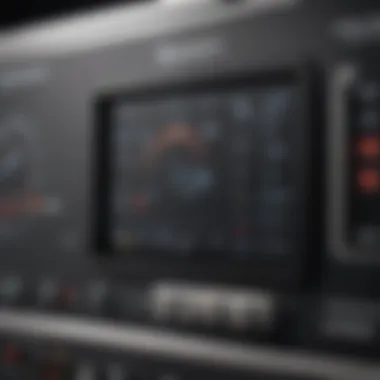Understanding Incubator Costs: A Comprehensive Guide


Intro
The hatching of eggs is a delicate process that requires careful consideration of various factors. This article explores the cost of incubators, revealing how different types and features impact their pricing. Potential buyers will gain insights on functionalities, maintenance costs, and the overall investment required. The exploration also includes specific case studies and price comparisons across notable brands.
Types of Incubators
When looking at incubator costs, understanding the different types available is crucial. There are three main categories: manual, automatic, and advanced digital incubators.
- Manual Incubators: These require manual turning of eggs and are generally the most affordable option. Their price ranges from $50 to $200, depending on size and build quality.
- Automatic Incubators: Offering automated temperature and humidity control, these start from around $150 and can go up to $600. They also include egg turning features, minimizing human error.
- Advanced Digital Incubators: These high-tech options can be found priced anywhere from $300 to upwards of $1,000. They come with precise controls, monitoring systems, and even smartphone connectivity for remote management.
Factors Influencing Cost
Several factors contribute to the variation in incubator prices. Understanding these can help potential buyers make informed choices.
- Capacity: The number of eggs an incubator can hold directly affects its cost. Larger models that accommodate more eggs tend to be more expensive.
- Features: Built-in features such as automatic temperature control, humidity regulation, and user-friendly interfaces contribute to higher costs.
- Brand Reputation: Established brands often charge more due to their history of reliability and customer support.
- Materials and Build Quality: Incubators built with high-quality materials, such as insulated walls or heated air circulation, will generally cost more.
Hidden Costs
When budgeting for an incubator, potential buyers must consider more than just the initial purchase price.
- Egg Supplies: The cost of fertilized eggs varies, depending on the species and availability.
- Electricity Usage: Maintaining optimal temperature and humidity requires power. It can influence the overall cost of care for the incubator.
- Accessories and Maintenance: Additional tools, such as thermometers and humidity gauges, may be necessary. Regular maintenance checks also incur costs over time.
Understanding these factors simplifies your buying decision while preparing for a successful hatching experience.
Culmination
Intro to Incubators
Incubators serve as vital tools in the world of hatching eggs. Their importance extends to both commercial operations and hobbyist projects. Understanding the fundamentals of incubators provides insight into their functionality and aids potential buyers in making informed decisions. This section covers the definition, purpose, and historical context of incubators, establishing a basis for understanding their costs.
Definition and Purpose
Incubators are specialized devices designed to create and maintain an ideal environment for egg incubation. They regulate temperature, humidity, and airflow to ensure optimal conditions for embryonic development. These devices aim to replicate a hen's natural incubation process, providing the warmth and care necessary for eggs to hatch successfully.
Utilizing an incubator greatly enhances the hatching success rate. It also offers users more control over variables that affect incubation outcomes, unlike traditional methods. This control is particularly valuable for those wishing to hatch specific breeds with unique requirements. Understanding the purpose of incubators is crucial for buyers to choose the right model that fits their needs.
Historical Overview
The history of incubators dates back centuries. In ancient societies, people sought ways to hatch eggs without relying on birds. Early devices were simple structures made of clay or straw, which offered limited control over conditions. With time, designs evolved. By the 19th century, wooden boxes with ventilation systems and heat sources started gaining popularity. The advancements in scientific understanding of temperature and humidity control proved essential.
In the 20th century, incubator technology witnessed significant advancements, particularly with the introduction of electric models. These electric incubators featured thermostats, ensuring more precise temperature regulation. Innovations continued, leading to the creation of forced air incubators that improved air circulation, resulting in better hatching rates. Today, modern incubators incorporate advanced technology, with digital displays and automated features, marking a shift in how we approach egg incubation.
Understanding these historical developments provides context for current trends and pricing strategies in the incubator market. As technology progresses, the expectations and capabilities of incubators continue to rise, directly influencing consumer choices and costs.
Types of Incubators
Understanding the different types of incubators is crucial for anyone looking to invest in this technology for hatching eggs. Each type possesses distinct attributes, which can influence not only the price but also functionality and effectiveness in hatching eggs. Knowing the differences can help buyers make informed choices based on their specific needs, available space, and desired outcomes.
Still Air Incubators
Still air incubators are one of the simplest designs available on the market. In these incubators, hot air from the heating element rises, while cooler air remains at the bottom. This design creates a stable environment for egg incubation, which is beneficial for several reasons.
- Cost-Effective: They typically cost less than their forced air counterparts.
- Design Simplicity: The lack of fans makes them easier to operate and maintain.
- Ideal for Beginners: New hatchers may find still air incubators easier to manage.
However, temperature gradients can occur within the incubator. This can lead to uneven heating and possibly affect hatch rates. It's essential for users to monitor temperatures closely, often requiring manual adjustments.
Forced Air Incubators
Forced air incubators employ a fan to circulate warm air throughout the unit. This design promotes more even temperature distribution, resulting in more consistent incubation conditions.
- Improved Temperature Control: The fan helps to eliminate temperature variations, offering a more stable environment for the eggs.
- Higher Hatch Rates: With better temperature uniformity, users often observe better hatch rates compared to still air incubators.
- Advanced Features: Many forced air models come with digital controls for enhanced monitoring.
While these incubators tend to have a higher price point, the benefits may outweigh the additional costs, especially for serious breeders or those running incubating businesses.
Automatic vs.


Manual Incubators
The choice between automatic and manual incubators also plays a significant role in pricing and functionality. Manual incubators require users to adjust temperature and humidity levels manually, as well as to turn the eggs several times a day.
- Pros of Manual Incubators:
- Cons of Manual Incubators:
- Less initial investment required.
- Simplicity of design.
- More labor-intensive.
- Higher risk of human error in temperature and humidity control.
In contrast, automatic incubators handle egg turning and often feature advanced temperature and humidity controls.
- Pros of Automatic Incubators:
- Cons of Automatic Incubators:
- Hassle-free operation.
- Consistent environment for eggs.
- Typically more expensive.
- Dependence on electricity.
Ultimately, users should consider their budget, the scale of their hatching projects, and their comfort with technology. Each type has its advantages and disadvantages, making it critical to choose wisely based on personal circumstances and goals.
Factors Influencing Incubator Prices
Understanding the various factors that affect the prices of incubators is essential for anyone interested in purchasing one. The cost can vary widely based on several elements such as size, technology, brand reputation, and the quality of the materials used. Knowing these factors helps buyers make informed decisions and ensure they invest in an incubator that meets their specific needs.
Size and Capacity
The size and capacity of an incubator can greatly influence its price. Incubators are available in various sizes, catering to different needs, from small hobbyist models to large commercial units. Larger incubators tend to have a higher price point due to increased production costs and additional features that may be included.
When selecting an incubator, it is vital to consider the intended use. For example, if a user plans to hatch a small number of eggs, a small incubator will be sufficient and more affordable. In contrast, someone looking to hatch a larger batch, such as for a farm, will need a model with a greater capacity. Consequently, understanding the size you need can lead to better purchasing decisions.
Technology and Features
Temperature Control
Temperature control is a critical aspect of incubators. Maintaining the right temperature is vital for successful hatching. Incubators with advanced temperature control systems can automatically adjust to changes and ensure consistent warmth. This feature is highly beneficial as it minimizes the risk of human error.
Many modern incubators come with digital thermostats that provide accurate readings and adjustments. However, such models may come with a higher price tag. Poor temperature control can lead to significant losses in hatching success, which makes investing in quality necessary.
Humidity Control
Humidity levels are equally important, as they impact the developing embryos inside the eggs. Good humidity control systems help maintain optimal moisture levels throughout the incubation period. Incubators that provide consistent humidity monitoring and management may be seen as a worthwhile investment.
Such systems often come with built-in hygrometers and automatic water refill mechanisms. While these features can increase the cost of an incubator, they can improve hatching rates and success, making them a popular choice for serious enthusiasts and professionals alike.
Egg Turning Mechanism
An effective egg turning mechanism is vital for ensuring that eggs receive even heat and wear down any potential development issues. Automatic turning features simplify the process and reduce the labor needed on the user's part. These automatic systems tend to be more expensive than manual alternatives, where users must turn the eggs themselves.
Still, automatic egg turners can save time and reduce the risk of errors. Ultimately, the type of egg turning mechanism can also play a significant role in the investment decision.
Brand Reputation
The brand under consideration can affect an incubator's price as well. Established brands may offer products at a premium due to their reputation for reliability and quality. A reputable brand usually means better customer support, warranties, and overall performance.
Buyers should research brands to understand their track record. Looking at customer reviews and feedback can provide insight into the value of choosing a well-regarded name in the market.
Material and Build Quality
The materials and build quality of an incubator are additional factors that can dramatically influence the price. Incubators made from high-quality, durable materials may cost more but often last longer and perform better. Factors such as insulation and construction can also determine how well the incubator maintains stable conditions for the eggs.
Investing in a well-constructed incubator is a long-term decision. Cheaper alternatives may save money upfront but often lead to higher operational costs due to poor efficiency and increased need for repairs or replacements.
In summary, understanding the factors that influence incubator prices is essential. By examining size, technology, brand reputation, and material quality, potential buyers can make informed decisions and ensure their investment meets their expectations.
Price Range Overview
Understanding the price range of incubators is essential for potential buyers. This section elucidates how various pricing tiers impact the features and functionalities of incubators. It also enables users to establish a budget that aligns with their hatching goals. By becoming familiar with different price categories, buyers can make informed decisions that suit their needs and financial capabilities.


Entry-Level Incubators
Entry-level incubators serve as an introduction to the world of egg incubation. These models typically range from fifty to two hundred dollars. They generally have basic functionalities and are suitable for hobbyists or those new to hatching. Features include simple temperature control and limited capacity, often designed to hatch a small number of eggs. Nonetheless, they provide practical experience without a significant financial commitment.
Some examples of entry-level incubators are the Little Giant 9200, which offers basic temperature regulation and can accommodate a few eggs, or the Presto Egg Incubator, known for its user-friendly interface.
Key Features of Entry-Level Incubators:
- Basic temperature regulation
- Limited egg capacity
- Manual egg turning in most cases
- Designed for beginners
Mid-Range Incubators
Mid-range incubators typically cost between two hundred to six hundred dollars. These units offer enhanced features compared to entry-level models. Users can expect better temperature stability, automatic egg turning mechanisms, and increased capacity. These incubators may also incorporate humidity control, which is beneficial for higher hatch rates.
Popular options in this category include the Genesis 1588, which features an easy-to-read digital display, and the Brinsea Mini II Advantage, known for its reliability and intuitive design.
Characteristics of Mid-Range Incubators:
- Automatic egg turning to improve hatching success
- More precise temperature regulation
- Greater capacity for larger hatching projects
- Increased user control over humidity levels
High-End Incubators
High-end incubators are designed for serious breeders and can cost between six hundred to several thousand dollars. These machines often come equipped with advanced technology, including PID temperature control, which offers remarkable stability. Many high-end models provide dual channels for temperature and humidity, allowing significant control over hatching conditions. They are built with durable materials and have larger capacities for extensive breeding operations.
Examples include the IncuView EX, known for its transparency and user-friendly setup, and the Rcom King Suro, which is praised for its innovative features and reliability.
Distinguishing Features of High-End Incubators:
- State-of-the-art technology for optimal hatching conditions
- Extensive data logging for monitoring incubation
- Professional-grade materials and build quality
- Scalability for larger operations
Investing in the right category of incubator can influence not just the cost but also the success of hatching eggs. It is crucial to evaluate your requirements and potential future goals when making a choice.
Case Studies: Comparing Incubator Prices
Exploring the costs of incubators through case studies offers essential insights for potential buyers. It allows individuals to evaluate value and functionalities based on actual market performance. By comparing real-world examples, one can identify patterns in pricing, assess what features drive costs, and determine which brands provide the best return on investment.
Analyzing specific cases enables buyers to make knowledgeable decisions. They can understand how certain characteristics, such as technology and build quality, influence overall expenses. This section will examine different scenarios, giving a clearer picture of what to expect when venturing into the incubator market.
Popular Brands and Pricing
When considering an incubator, brand reputation often plays a significant role in pricing. Popular brands, known for their reliability and advanced features, can command higher prices. Here are some notable brands to keep in mind:
- Brinsea: Renowned for innovative technology, Brinsea units often range from entry-level to high-end prices, depending on functionality.
- Sportsman: Known for their large capacity, Sportsman offers models that vary significantly in price based on size and automation levels.
- Little Giant: This brand typically provides economical options. Their incubators are popular for budget-conscious buyers.
- Coleman: They offer a good balance of affordability and quality, appealing to both novice and experienced users.
Price points can vary widely among these brands, depending significantly on the features offered.
User Reviews and Experiences
User experiences are invaluable when it comes to selecting an incubator. Reviews often reveal real-life performance, potential drawbacks, and advantages that may not be immediately apparent in a product description. It's critical to consider:
- Functionality: Many users emphasize how useful specific features, like digital temperature controls or automatic egg turners, enhance the hatching process.
- Durability: Some brands may have a reputation for longevity. Customer feedback can signal if an incubator withstands time or needs frequent repairs.
- Support and Service: Buyers often cite manufacturer support as a key factor in their purchase satisfaction. Effective customer service can alleviate many post-purchase concerns.
"Choosing an incubator means investing in a consistent hatching experience. Reviews guide you through the noise of marketing."
By synthesizing opinions and outcomes from various users, future buyers can gauge whether a model fits their specific needs. Such insights inform expectations and help in navigating the complexities of incubator ownership.
Long-Term Costs of Owning an Incubator
Owning an incubator is not merely a one-time investment; it involves several long-term costs that potential buyers need to consider. Understanding these costs is crucial for anyone who intends to use incubators for hatching eggs regularly. Recognizing these ongoing expenses helps in budgeting effectively and enables better decision making regarding the type and model of incubator to purchase.
Energy Consumption
Energy consumption is one of the most significant ongoing costs associated with incubators. The amount of electricity needed varies significantly depending on the type of incubator, its size, and its operational efficiency.
- Still air incubators generally consume less energy than forced air equivalents.
- Forced air incubators require fans for air circulation, hence using more power.
- Automatic models usually have energy-efficient features that can reduce overall usage.


Using an incubator continuously for several weeks can lead to substantial electricity bills. Therefore, it is advisable to evaluate the energy efficiency ratings of different models before making a purchase. Tracking utility bills over time can also help in analyzing the long-term cost-effectiveness of a particular incubator.
A quality incubator may save energy, impacting long-term operational costs positively.
Maintenance and Repairs
Another critical consideration is maintenance and repair costs. Like any machine, incubators require regular maintenance to ensure they are functioning correctly.
- Regular cleaning is essential to prevent contamination and maintain egg viability.
- Check and calibrate temperature and humidity settings periodically to ensure optimal conditions.
- Some models may require periodic servicing, particularly those with more advanced technology.
While many issues can be addressed easily, some repairs may require professional assistance, which can become an additional expense over time. It's smart to consider the manufacturer’s warranty and the availability of service centers when selecting an incubator, as these can influence long-term maintenance costs significantly.
Replacement Parts
Over time, certain parts of the incubator may need replacement due to wear and tear. Understanding these costs is vital for budgeting effectively.
- Heating elements, fans, and thermostats are common components that may require replacement.
- Parts availability is also critical; models with widely available parts can be more cost-effective in the long run.
- Some manufacturers offer replacement parts at a reasonable cost, while others do not.
It's advisable to research the track record of brands regarding the availability and pricing of replacement parts. Consider models known for durability and easy part replacement as they can significantly reduce long-term expenses associated with ownership.
Buying Guidelines
Understanding the buying guidelines for incubators is crucial for anyone seeking to invest in this equipment. A well-informed choice can significantly affect not only the immediate cost but also long-term satisfaction and operational efficiency. Knowing where to buy and what features to search for can help align your purchase with your specific needs. This section lays out key factors buyers should consider when contemplating their incubator options.
Where to Buy Incubators
When it comes to purchasing an incubator, several avenues are available. These include online platforms and brick-and-mortar stores. Consider the following options:
- Online Retailers: Websites such as Amazon, eBay, and specialized agricultural supply sites often carry a wide range of brands and models. Online shopping provides the advantage of comparing prices easily.
- Local Farm Supply Stores: These stores may offer incubators suited to regional needs and local climates. Visiting them allows potential buyers to seek advice from knowledgeable staff.
- Specialized Hatchery Suppliers: Companies that focus on poultry supplies, like Murray McMurray Hatchery or Stromberg's Chickens, often have comprehensive selections of high-quality incubators.
- Second-Hand Markets: Platforms like Craigslist or Facebook Marketplace can have used incubators at lower prices. However, vigilance is needed regarding the condition and functionality of such equipment.
Each option has its pros and cons based on price, customer service, and available models, thus one must evaluate what fits their needs best.
What to Look for in an Incubator
When selecting an incubator, various factors come into play that can influence your ultimate choice. Here are essential features to consider:
Temperature Control
Temperature stability is vital for successful hatching. Look for incubators that offer reliable temperature regulation and even heat distribution. Digital displays are often recommended for precision.
Humidity Control
Similar to temperature, humidity levels must be monitored closely. Features that facilitate easy adjustment and tracking of humidity levels contribute to a conducive hatching environment.
Egg Turning Mechanism
An automatic egg turning feature can be highly beneficial. This function prevents the eggs from sticking to the incubator's interior and ensures even exposure to heat.
Size and Capacity
Calculating your expected hatch needs is crucial. Incubators vary widely in egg capacity. Choose a size that aligns with your goals without being overly cumbersome.
Build Quality
Durability matters. Incubators constructed from robust materials, particularly those insulated to maintain temperature, offer better long-term performance.
Ultimately, the decision should reflect your individual requirements and potential future hatching projects. This careful consideration can enhance the effectiveness of your investment.
Important Note: It’s beneficial to read user reviews and possibly reach out to existing owners of particular models for insights before making a final purchase.
End
In the realm of incubators, comprehending costs transcends mere acquisition. It involves a broader understanding of how to optimize investments for long-term hatching success. This article serves as a guide to help readers navigate the various factors influencing incubator costs and their implications.
Summary of Key Points
As explored throughout the article, several core points warrant earnest consideration:
- Types of Incubators: Understanding the differences between still air and forced air incubators can greatly influence initial purchase decisions.
- Factors Affecting Price: The size, technology, brand reputation, and material quality all contribute to the cost. Each factor caters to specific needs and preferences, a vital consideration when determining budget and functionality.
- Long-Term Ownership Costs: Beyond initial costs, ongoing expenses such as energy consumption, maintenance, and the cost of replacement parts are crucial for assessing the overall financial commitment.
- Buying Guidance: Knowing where to purchase incubators and identifying the key features that best suit individual needs leads to more informed investment decisions.
Final Thoughts
Acquiring an incubator involves an exchange of financial resources for the promise of producing chicks. However, the decisions go deeper than that. Factors such as technology advancements and brand reliability play a critical role in these machines’ efficiency and effectiveness. Especially to eggs enthusiasts and small-scale farmers, understanding incubator costs allows better planning and execution of their hatching endeavors. As you embark on this journey, keep in mind the dynamics of price versus functionality and ensure your choices align with your needs and aspirations. For those intrigued by this venture, the investment can indeed yield rewarding results.







